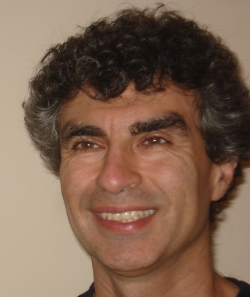Deep Learning (Presentation Slides – PDF)

Yoshua Bengio
University of Montreal
Abstract: Deep learning has arisen around 2006 as a renewal of neural networks research allowing such models to have more layers. Theoretical investigations have shown that functions obtained as deep compositions of simpler functions (which includes both deep and recurrent nets) can express highly varying functions (with many ups and downs and different input regions that can be distinguished) much more efficiently (with fewer parameters) than otherwise. Empirical work in a variety of applications has demonstrated that, when well trained, such deep architectures can be highly successful, remarkably breaking through previous state-of-the-art in many areas, including speech recognition, object recognition, language models, and transfer learning. This talk will summarize the advances that have made these breakthroughs possible, and end with questions about some major challenges still ahead of researchers in order to continue our climb towards AI-level competence.
Yoshua Bengio received a PhD in Computer Science from McGill University, Canada in 1991. After two post-doctoral years, one at M.I.T. with Michael Jordan and one at AT&T Bell Laboratories with Yann LeCun and Vladimir Vapnik, he became professor at the Department of Computer Science and Operations Research at Université de Montréal. He is the author of two books and more than 200 publications, the most cited being in the areas of deep learning, recurrent neural networks, probabilistic learning algorithms, natural language processing and manifold learning. He is among the most cited Canadian computer scientists and is or has been associate editor of the top journals in machine learning and neural networks. Since ‘2000 he holds a Canada Research Chair in Statistical Learning Algorithms, since ‘2006 an NSERC Industrial Chair, since ‘2005 his is a Senior Fellow of the Canadian Institute for Advanced Research and since 2014 he co-directs its program focused on deep learning. He is on the board of the NIPS foundation and has been program chair and general chair for NIPS. He has co-organized the Learning Workshop for 14 years and co-created the new International Conference on Learning Representations. His current interests are centered around a quest for AI through machine learning, and include fundamental questions on deep learning and representation learning, the geometry of generalization in high-dimensional spaces, manifold learning, biologically inspired learning algorithms, and challenging applications of statistical machine learning.
Methods of Achieving Perfect Recognition Scores (Presentation Slides – PDF)

Ching Yee Suen
Concordia University
Abstract: Recognition systems inevitably make some errors somewhere at some time. Achieving perfect recognition without making errors has been the dream of researchers in the field of pattern recognition. This talk summarizes my efforts and experiences towards this goal. The first part of this talk will describe my early efforts in building different types of classifiers based on structural analyses and skeletonization, density distributions, neural networks, tree hierarchies, support vectors, and so on. To improve the recognition rates further, multiple classifiers were explored involving numerous types of geometric and structural features, and ensembles of hybrid classifiers. Later, error reduction machines were introduced and investigated. Several effective ways of heading towards perfect scores will be presented with real-life examples and promising research results.
Ching Yee Suen is the Director of CENPARMI and the Concordia Chair on AI & Pattern Recognition. He received his Ph.D. degree from UBC (Vancouver) and his Master’s degree from the University of Hong Kong. He has served as the Chairman of the Department of Computer Science and as the Associate Dean (Research) of the Faculty of Engineering and Computer Science of Concordia University. Prof. Suen has served at numerous national and international professional societies as President, Vice-President, Governor, and Director. He has given 45 invited/keynote papers at conferences and 195 invited talks at various industries and academic institutions around the world. He has been the Principal Investigator or Consultant of 30 industrial projects. His research projects have been funded by the ENCS Faculty and the Distinguished Chair Programs at Concordia University, FCAR (Quebec), NSERC (Canada), the National Networks of Centres of Excellence (Canada), the Canadian Foundation for Innovation, and the industrial sectors in various countries, including Canada, France, Japan, Italy, and the United States. Dr. Suen has published 4 conference proceedings, 12 books and more than 495 papers, and many of them have been widely cited while the ideas in others have been applied in practical environments involving handwriting recognition, thinning methodologies, and multiple classifiers. Dr. Suen is the recipient of numerous awards, including the Gold Medal from the University of Bari (Italy 2012), the IAPR ICDAR Award (2005), the ITAC/NSERC national award (1992), and the “Concordia Lifetime Research Achievement” and “Concordia Fellow” Awards (2008 and 1998 respectively). He is a fellow of the IEEE (since 1986), IAPR (1994), and the Academy of Sciences of the Royal Society of Canada (1995). Currently, he is the Editor-in-Chief of the journal of Pattern Recognition and an Adviser or Associate Editor of 5 journals.
Automatic Analysis of Facial Expressions (Presentation Slides – PDF)

Maja Pantic
Imperial College
Abstract: Facial behaviour is our preeminent means to communicating affective and social signals. This talk discusses a number of components of human facial behavior, how they can be automatically sensed and analysed by computers, what is the past research in the field conducted by the iBUG group at Imperial College London, and how far we are from enabling computers to sense and recognise human facial expressions and behaviour.
Maja Pantic obtained her PhD degree in computer science in 2001 from Delft University of Technology, the Netherlands. Until 2005, she was an Assistant/ Associate Professor at Delft University of Technology. In 2006, she joined the Imperial College London, Department of Computing, UK, where she is Professor of Affective & Behavioural Computing and the Head of the iBUG group, working on machine analysis of human non-verbal behaviour. From November 2006, she also holds an appointment as the Professor of Affective & Behavioural Computing at the University of Twente, the Netherlands.
Prof. Pantic is one of the world’s leading experts in the research on machine understanding of human behavior including vision-based detection, tracking, and analysis of human behavioral cues like facial expressions and body gestures, and multimodal analysis of human behaviors like laughter, social signals, and affective states. She has published more than 200 technical papers on her research in the field. Her work is widely cited and was covered by popular press many times (including by New Scientist, BBC Radio, and NL TV 1 and 3). In 2011, Prof. Pantic received BCS Roger Needham Award, awarded annually to a UK based researcher for a distinguished research contribution in computer science within ten years of their PhD.
Prof. Pantic serves as the Editor in Chief of the Image and Vision Computing Journal (IVCJ/ IMAVIS), an Associate Editor of the IEEE Transactions on Pattern Analysis and Machine Intelligenve (IEEE TPAMI), and an Associate Editor of the IEEE Transactions on on Affective Computing (IEEE TAC). She is an IEEE Fellow.
Large-Scale Visual Computing: Challenges and Opportunities (Presentation Slides – PDF)

Tieniu Tan
Chinese Academy of Sciences
Abstract: The widespread deployment of visual sensors such as surveillance cameras leads to the explosion of visual data. The timely processing and understanding of such massive information presents a clear challenge as well as a great opportunity for computer vision. This talk starts with a brief introduction to the concept of large-scale visual computing and outlines the status quo of the field as well as the main research challenges. It focuses on discussing some of the key issues in large-scale visual computing such as large-scale feature representation and large-scale modelling. It also discusses some promising directions for future research.
Tieniu Tan received his B.Sc. degree in electronic engineering from Xi’an Jiaotong University, China, in 1984, and his MSc and PhD degrees in electronic engineering from Imperial College London, U.K., in 1986 and 1989, respectively.
In October 1989, he joined the Department of Computer Science, The University of Reading, U.K., where he worked as a Research Fellow, Senior Research Fellow and Lecturer. In January 1998, he returned to China to join the National Laboratory of Pattern Recognition (NLPR), Institute of Automation of the Chinese Academy of Sciences (CAS) as a full professor. He was the Director General of the CAS Institute of Automation from 2000-2007, and the Director of the NLPR from 1998-2013. He is currently Director of the Center for Research on Intelligent Perception and Computing at the Institute of Automation and also serves as Deputy Secretary-General of the CAS and the Director General of the CAS Bureau of International Cooperation. He has published more than 450 research papers in refereed international journals and conferences in the areas of image processing, computer vision and pattern recognition, and has authored or edited 11 books. He holds more than 70 patents. His current research interests include biometrics, image and video understanding, and information forensics and security.
Dr Tan is a Member (Academician) of the Chinese Academy of Sciences, Fellow of The World Academy of Sciences for the advancement of sciences in developing countries (TWAS), an International Fellow of the UK Royal Academy of Engineering, and a Fellow of the IEEE and the IAPR (the International Association of Pattern Recognition). He is Editor-in-Chief of the International Journal of Automation and Computing. He has given invited talks and keynotes at many universities and international conferences, and has received numerous national and international awards and recognitions.